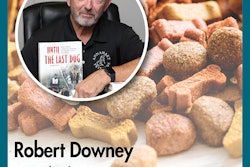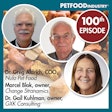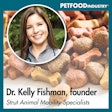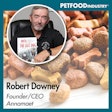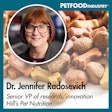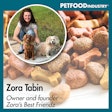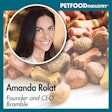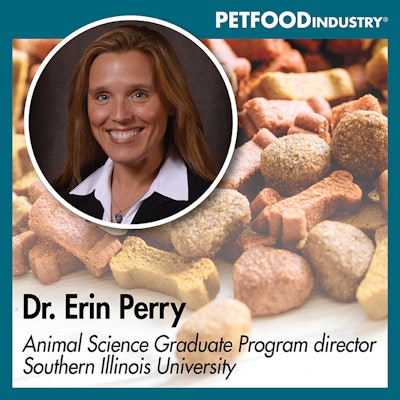
In this episode of Trending: Pet Food, Lindsay Beaton speaks with Dr. Erin Perry about the unique nutritional considerations for working dogs. Dr. Perry explains how working dogs — from military and law enforcement canines to medical alert and therapy dogs — have specialized dietary needs that go beyond standard pet food formulations. The pair also discuss how research conducted on working dog nutrition can benefit the broader companion dog population, particularly in areas like managing GI distress and promoting gut health through dietary diversity.
We want to thank Rangen Pet Nutrition for sponsoring this podcast. Rangen Pet Nutrition is your trusted partner in advancing pet health. From antioxidants to custom premixes and pure yeast solutions, they help pet food companies create superior nutrition with innovative science and dependable expertise. Learn more on LinkedIn at Rangen Pet Nutrition.
Lindsay Beaton, editor, Petfood Industry magazine and host, Trending: Pet Food podcast: Hello, and welcome to Trending: Pet Food, the industry podcast where we cover all the latest hot topics and trends in pet food. I'm your host and editor of Petfood Industry magazine Lindsay Beaton, and I'm here today with Dr. Erin Perry, canine handler, evaluator and instructor for the Federal Emergency Management Agency (FEMA), and director of the Animal Science Graduate Program at Southern Illinois University. Hi Erin, and welcome!
Dr. Erin Perry: Hi. Good morning!
Beaton: In case you're unfamiliar with Dr. Perry, here's what you need to know.
She is an award-winning scientist and author with more than two decades of experience with working canines. Dr. Perry has served on the DoD Military Working Canine Research Forum Steering Committee, the U.S. Joint Forces NORTHCOMM Canine Decontamination Working Group, the American Kennel Club Canine Health Foundation Review panel, and as a consultant for various law enforcement and emergency response agencies.
Dr. Perry's research focuses on challenges faced by working dogs in operational conditions. Her depth of knowledge when it comes to working dogs and their needs is why I've brought her on today to answer this question: What are some of the unique considerations when it comes to working dog nutrition?
Dr. Perry, I want to start with a 101 question that I think is really important to clarify, even though it is a pretty simple question. What qualifies as a working dog?
Dr. Perry: What a great question to start the conversation. I think depending upon the person to whom you're speaking, you may get different answers. Congress has produced a very specific definition for working dogs that's obviously viewed through the lens of federal dog programs, and that's just a dog that has received formal training to perform a productive task.
Probably a lot of folks would include a lot of different working dogs in that definition. There are emotional support dogs, there are therapy dogs, there are medical alert dogs, in addition to the more traditional military or law enforcement or search and rescue type dogs that people would probably think of more easily. I think it's important that we collectively consider all of those dogs and the work that they do in conjunction with their human counterparts, because all of them contribute to human society.
The partnership between humans and dogs goes back thousands and thousands of years, whether they're sniffing out bombs or they're sniffing out diabetes and warning you of a potential medical episode that's about to occur. Their value to their human partner is without measure, and we want to make sure that we're doing the very best that we can for them in terms of nutrition, because they take such good care of us.
Beaton: That I think is probably the broadest definition of working dog, because it encompasses everything that anybody might think is a working dog, including their own pets. But nutrition wise, I feel there's probably a bit of a narrower definition of working dog purely from a caloric intake perspective. Can we talk about that a little bit and discuss what working dog means when it comes to nutrition?
Dr. Perry: Absolutely. When you're talking about specific nutritional requirements, there's obviously, as you pointed out, a caloric difference there. If you're talking about military dogs, law enforcement dogs, those dogs are going to have a much higher requirement for energy and for protein because they're burning calories.
Muscle repair, muscle regeneration, is going to require specific protein support, specific amino acids. We think of calories and we think of protein pretty easily. Most commonly, those are going to be dogs that are literally working a shift beside their human counterpart. They're patrolling an area. There are dogs that are doing explosive detection. TSA dogs screening bags all day at the airport. Even though some of them may be working in a climate controlled environment, there is constant effort that those dogs are expending.
The Customs and Border Patrol dogs that work screening vehicles as they enter into our country very frequently are working doing that same on leash detection. While their energy expenditure may not be huge in terms of running and jumping and chasing, their energy expenditure is much higher simply because of the more extreme environment that they're working in. They're spending a lot of calories trying to just perform thermoregulation. They're working in 100-degree-plus weather a lot of time, and we have to support their nutrition very carefully, because you can't just dump a lot of extra fat into their diet. That has to be balanced with a lot of other factors, when you consider hydration requirements, when you consider GI stability.
It's not just as easy as let's add more calories or let's add more protein. You really have to consider the whole GI health system and the way that that's going to impact the dog in terms of not just nutrient needs, but then obviously there are elimination needs that have to be met as a requirement of whatever the dog consumes. We've got to manage that in a way that allows the dog to have a very healthy and a very stable GI tract. It delivers the nutrients that they need, but it does it in a way that doesn't create any GI distress. Sometimes that can be a little bit tricky.
Beaton: How does a handler manage something that, because there are commercial pet foods out there for working dogs, and there are pet food companies that even specialize in that. But it sounds even a commercially available pet food for a working dog might not be specific enough. Is there a lot of customization going on among the group of people who have to feed working dogs? Or how do you manage that in the commercial space with what's available?
Dr. Perry: That is a great question. There are a lot of companies that have done some really tremendous research, advancing what we know about working dogs, and a lot of it is specific to breed. Several companies have done some really good work investigating differences in the size of the GI tract, differences relative to protein or calorie absorption or enzyme production in some breeds versus another. Even though working dogs typically are larger breed dogs, and we've got differences there, just relative to size. There are also some differences that have to be considered, as you pointed out, and perhaps customized.
One of the ways that a lot of handlers do that they manage their dog's body condition score. You're constantly evaluating the weight and the condition of the dog that you're partnering with. But you also can do that simply by managing the way that you feed them. Feeding a dog one large meal at breakfast and then expecting that dog to work eight to 10 hours may not necessarily produce the best performance from that dog. Multiple smaller meals throughout the day may help that dog to be able to perform much more consistently. Multiple small meals are actually one of the ways that we recommend preventing bloat or GDV in dogs, which can be potentially fatal, and which afflicts working dogs much more commonly.
Again, simply because dogs in that working type of category tend to be from those deeper chested breeds. We see that medical circumstance arise in those breeds more commonly. The way that you feed them, along with what you feed them can have a big difference. One of the other things that I've been researching lately actually surrounds this, in my opinion, outdated theory that you should put them on one diet and leave them on it forever, and you should never change and never have any variety in their diet, because it can create an upset stomach, or it can create some kind of GI unpleasantness.
While I certainly understand the origin of that recommendation, and I understand where that thought process came from, it simply isn't consistent with what we know about GI health and just health in general. Some of the research that I've done has actually demonstrated that when you introduce variety into the dog's diet, they actually have a more healthy GI system simply by rotating ingredients. We actually did a study with the Search Dog Foundation out in California, and we took a large group of dogs and we put them all on the same base diet, really high quality, good performance diet, and we just added a different ingredient every week.
One week we added pumpkin, and one week we added a little extra dehydrated liver on top, and then the next week we added a little bit of blueberries. We just kept rotating ingredients. Every week, the dogs in the treatment group always had something different that their stomach and their GI tract was being exposed to. What we found at the end of that study was that the dogs that had diversity that was purposely introduced into their system, those dogs had reduced numbers of E. coli, which I think we all recognize as a pathogen and as a bad bacteria. Those dogs also had higher numbers of healthy bacteria.
We actually were able to positively impact these dogs' GI tract by purposely, continually adding something new to it. If you teach the stomach, if you teach the GI tract to tolerate difference, you can actually train it to be a more resilient and more healthy environment. We found those same results across many different species. That same result has been found in human studies and rodent models. We feel those data really make a lot of sense. If you think about it, just from a common sense standpoint, sometimes the healthiest dogs that we see that never had any GI issues whatsoever are the mutts that are just wandering around outside eating whatever they can find.
While that is obviously not the nutritional program that any of us would recommend, we do recognize the value of dietary diversity and how it contributes to GI stability. That's an area of research and an area of practical management that we feel working dog handlers do a really good job there, because they can then introduce some very small amounts, but they can introduce that diversity into their dog's diet and help to create that more hearty and more resilient system.
Beaton: I want to talk about the owner connection a little bit more. You've been a consultant for law enforcement and emergency response in terms of working with their canines. What do you think is the best way to disseminate this kind of nutritional information to working dog owners, who obviously have dogs with some pretty refined needs when it comes to nutrition, if they want to keep them at peak performance. I'm talking about everything from police dogs to farm dogs to racing dogs, sporting dogs, any dog with an increased nutritional need.
How do you get the right information out there to the pet owner that they can make sure they are doing right by their dogs? Because a lot of the information out there is for the average healthy adult dog, and they don't have the average dog.
Dr. Perry: I think that's a great question. As with many things in today's world, it all comes down to education and communication. A couple of years ago, the AAHA group, which is the group that governs veterinary hospitals in North America, produced a set of guidelines specific for working dogs, and it was this toolkit for veterinarians to have that gave very specific recommendations for working dogs in terms of different vaccination requirements, different parasite control requirements, as well as different nutritional management requirements.
I think toolkits and communication and opportunities for people who work in this space to talk with people who are producing this information for a greater community, these are the ways that we can get this information out that people understand. You've got to have a very high quality base diet to work from where you can count on the protein and the calories and the vitamin and mineral nutrient requirements to be met.
Nothing is ever going to replace high quality, well researched and good manufacturing processes in terms of quality pet food. However, we do have to do a better job of managing the health and the stability within the gut, and we can do that with the help of our veterinary partners and with the help of people who are bringing awareness to these discussions.
Beaton: I want to extend the awareness conversation a little bit, because there is an obesity epidemic when it comes to dogs, and a big component of that is simply over feeding. Pet parents don't know how much to feed their pet. They either can't read the back of the bag, they don't understand their dog's nutritional requirements properly. How do you mix that in with a high performing dog?
Because I think it can be easy for a pet owner to look at their dog who goes on a couple walks a day or hangs out at the dog park and runs around and think, okay, my dog needs more calories because it's exercising. Where is the line between active, normal dog versus working dog that has specific nutritional needs, and how does all of that play into what's going on in the regular pet space when it comes to obesity and body condition and all of that?
Dr. Perry: Quite frankly, that's another tough nut to crack. The obesity epidemic in the United States, specifically in our pet population, is one that has been recognized in the veterinary community for years, and the problem that we run into very frequently, I've run into this in my own family. As a matter of fact, I have wonderful parents who just want to overfeed because they equate feeding their pet with the love that they have for their pet.
Every time I give him a cookie or every time I give him a treat, I'm telling him how much I love him. What they don't understand is that what you are doing is fundamentally not only shortening his life, but you're fundamentally reducing the quality of his life, because he's no longer voluntarily mobile, because he's overweight that all he wants to do is lay on his bed and sleep all day.
I think if we talked a little bit more about the quality of life that the pet is experiencing, I think that may resonate a little bit more with the pet owners. Obviously, there have been multiple studies. I think Purina was probably the first company that produced a study really well done that actually documented the amount of the lifespan for dogs that were obese versus dogs that were lean. The problem is, quite frankly, most owners don't recognize an overweight dog when they see it. They think this cute and very round and very sausage tube appearance is healthy. That's another area, quite frankly, where education probably needs to catch up.
Those body condition score charts that we see very frequently hanging in a veterinarian's office, they're a little bit too abstract. The average pet owner can't really equate what their dog looks, especially if it's a different breed, because the dogs on those charts don't look their dogs. I think if we had a way that we could literally capture a snapshot of your dog, of your pet, and say this is what it should look. It should have a waist. There should be some shape to it. It actually shouldn't look a sausage.
You know, we've got AI now, and wonderful AI tools that we know are part of the feed industry. If we had an AI toolkit that a veterinarian or that feed companies, the feed industry could use that would be able to integrate a specific pet's image and project this is what they should look. This is ideal, and if you fit this ideal, here's how it impacts their quality of life.
I think that connection would actually do more good in terms of educating the owner, rather than abstract posters that they just can't connect with and this abstract feeling of well, but I'm not feeding them, but they're hungry, and I love them. I think we have to do a better job of equating love and managing health and quality of life versus love and I'm giving them treats and cookies, because they're not the same thing.
Beaton: We've talked a lot about the depth to which we can determine nutritional requirements for working dogs, for the average dog, for pets in general. How have those nutritional requirements, particularly for working dogs, been refined over the years. What do we know about working dog needs now that maybe weren't considered 25 or 30 years ago?
Dr. Perry: Wow, that's a great question. We've got a couple leaders in animal nutrition that have really paved the way for a lot of this science. When you think about working dog nutrition, many times you're talking about dogs that are using their nose. Their ability to perform olfactory based work is critical. Factors that impact their ability to smell, or that impact their ability to successfully search and smell, those are the things that, in my opinion, have received more attention now.
Mike Davis, over at Oklahoma State University, he did quite a bit of work related to exercise physiology, and for his working dog model, he used sled dogs. Sled dogs are probably the very best example that we have of extreme canine athletes. They're working, obviously in extreme environments, and their caloric output, in terms of calories they're burning through, is significantly greater than any of our detection dogs or dogs in any other working or performance or sport discipline.
When you're talking extreme canine athletes, Mike Davis has probably done more research about that than anyone else in the world, and he has produced a large body of work relative to calorie requirements, relative to the way that we actually measure exertion in their muscles. There have been some real significant advances there.
Russ Kelley and Paul Wagner and Craig Angle, Melissa Singletary, these are some of the folks that have done some work down at Auburn University. They've got a tremendous olfactory sciences program down there. They've done quite a bit of work specifically investigating olfaction and the way dogs work within a detection task. The advances that have been made relative to the way that we now understand olfaction impacts the body and the system, those have been really instrumental in the way that we approach training and selecting working dogs, specifically some of their genetic research.
We now know there are differences in the way that females, the mama dogs, raise their puppies. We know that impacts the kind of success a working dog will have. One of the studies that they conducted that was just incredibly fascinating to me, they looked at mothering style, and what they found was that females who made their puppies stand and walked away, they didn't lay, they didn't snuggle and cuddle. They weren't the most nurturing mom, but they had puppies who were much more independent, who tended to be better at independent problem solving. Mothers who laid and snuggled and gave probably a little bit more of that helicopter mom type of parenting, those puppies were not as independent, tended to look at their human counterparts for problem solving, and they just had a very different working approach. It doesn't mean that one is bad and one is good. It means you're producing puppies that are going to be successful in very different working dog disciplines.
Because if you have an explosive detection dog, you need that dog to be much more independent, and you don't want that dog to be looking back at its handler to solve the problem. Conversely, if you have a vision or a medical support dog that's working in tandem with a partner that never leaves their human side, you want that dog much more focused on its human handler, and you want that dog to be able to navigate some of those things with feedback coming from the handler. There's a fine line there, because obviously dogs that require support for vision, they have to straddle the line between I want to be able to stay partnered up with my human, but I have to make some of these choices independently.
There are some real specific discipline criteria that have to be considered when we're talking about working dogs. Knowing that the genetics and the parenting style, the olfactory tasks, the fatigue, the extreme environment, all those factors have to go into the way that we manage nutrition for these dogs, it's no wonder that there isn't a one size fits all product, because the jobs that they do are definitely not fitting into a one size fits all category.
Beaton: That is fascinating, and some of that is nuanced. Do you think any of the research that has gone on in the working dog nutrition space can be adapted to the non working dog nutrition space? Should we be focusing as much on a customized experience for the average dog as we do for working dogs?
Dr. Perry: I think that is a great question. In my opinion, I think the research that's done in working dogs actually benefits the larger companion dog population, and I'll give you one specific example. GI distress is one of the most common complaints or problems that working dogs face, most commonly, because typically these dogs are working with some sort of public exposure. If it's a law enforcement dog, if it's an airport screening dog, it doesn't matter what the venue is, the majority of those working dogs are operating in a public space.
Bowel incontinence, diarrhea, those kinds of problems create a significant issue, because if you're not able to have access to an area for immediate elimination, and you have a dog that has diarrhea or that you know is going to have some GI distress that basically takes that dog out of service for the day. That's a big problem.
Investigating ways that we can either prevent or mitigate or reduce the duration of GI distress and diarrhea, obviously, that has a real significant impact for dogs in working dog fields, but it also has a pretty big benefit for companion dogs, because most of us have taken our dogs with us for a visit to Grandma's house for the weekend and travel stress very frequently results in GI distress. The research that's been done to minimize GI problems relative to travel stress in working dogs absolutely benefits companion dogs as well.
There's some fiber supplementation, there's some probiotic work, there's some ingredient manipulation that we can do to prevent or minimize those fecal issues. Those types of studies, those types of data that have been generated, the target was a benefit for working dogs, but the broader application is absolutely beneficial to companion dogs at large.
Beaton: As we wrap up our conversation today, I want to talk more about research and what's coming down the pipeline. We've mentioned biotics, talked a lot about gut health. I have to believe there's probably some more research going on out there right now when it comes to that. What is the most interesting research to you out there right now, in terms of working dog nutrition?
Dr. Perry: Of course, I'm a little bit biased, because everyone is very focused on the field they're working within. I feel nutrition is such an easy fix for many problems. I feel oftentimes it's the best insurance policy that you never have to buy. I think if we can do a better job figuring out how to manage and produce a heartier and a more resilient gut, if we can figure out how to produce products that allow the dog to have flexibility in their diet, if we can come up with feeding regimens to help educate owners how to introduce diversity into the diet that's going to be beneficial for the dog.
We've got some incredibly smart people, Jan Suchodolski and Deb Zoran and Cindy Otto, and I already mentioned Mike Davis and Eric Altom. There are some really smart cookies working on these problems. It's not just about calories and protein anymore. We have to consider the whole health and the whole system of the dog. Dumping more calories in, dumping more probiotics in, doesn't necessarily solve the problem, because you have to consider the whole system. If what you're doing actually introduces more calories into the diet, but it actually increases diarrhea or loose stool, then you haven't necessarily solved a problem, and you may actually have made it worse. In my opinion, the solutions to a lot of these issues moving forward is collaboration.
It's bringing these really smart people that are working on different pieces of this problem together and figuring out how we can connect the dots of all of this research that's been done, and how do we make it much more broadly applicable and much easier to understand for veterinarians who are the front line in terms of educating dog owners. That's what I'd to see. I'd to see an alliance or a consortium or some group that would figure out how to bring together all of these really smart people, because we've got a lot of them.
Kelly Swanson has probably done more microbiome research than anyone else in our entire industry, and he's incredibly easy to collaborate with. Jan Suchodolski is another. If there's an incentive, or if there's a mechanism to formally bring these people together and try to connect the dots, wouldn't that be a great thing? I don't think the NRC is going to be updated. It's years and years and years out of date. How are we going to address that? How are we going to address the decades of research and findings that have been produced since the last publication of the NRC? What's our solution to a cohesive and comprehensive way to disseminate that information? I don't have the answer for that question. Somebody smarter than me is going to have to figure that out, but in my opinion, that's how we're going to move this needle.
Beaton: Well, I love that, giving the industry a call to action. Anyone, if anyone has any ideas, get in touch with Erin.
Thank you much for coming on today, because there are many different dog food formulations out there for life stages and breeds and functional. It's been super interesting to focus on one group, across all those categories that we know has needs beyond that of an average dog, and then how that research for working dog nutrition can disseminate out into the larger companion dog population. Really good conversation. Thank you very much for being on.
Dr. Perry: You're welcome.
Beaton: Before we go, I always to do a little plug for my guest. Where can people find more information about you and your work?
Dr. Perry: I'm available on the Southern Illinois University website. My email is [email protected]. I love to collaborate. I think we've got many smart people in this industry. If there's a way that I can participate, if there's a way that we can work together, if you've got some samples sitting in a freezer and you think, "hey, I wonder if there's something that we could look at from these fecal samples that have been stored for 10 years." I'd love to discuss that, because there's little funding available for this research.
We really have to be very purposeful and very willing to put ego aside, and let's advance the science for the benefit of the dogs. Again, they take such good care of us, it is incumbent upon us to take care of them.
Beaton: That is very true. Perfect. That's it for this episode of Trending: Pet Food. You can find us on petfoodindustry.com, SoundCloud or your favorite podcast platform. You can also follow us on Instagram @trendingpetfoodpodcast. If you want to chat or have any feedback I'd love to hear from you, feel free to drop me an email [email protected].
Of course, thanks again to our sponsor, Rangen Pet Nutrition for sponsoring this podcast. Rangen Pet Nutrition is your trusted partner in advancing pet health. From antioxidants to custom premixes and pure yeast solutions, they help pet food companies create superior nutrition with innovative science and dependable expertise.
Once again, I'm Lindsay Beaton, your host and editor of Petfood Industry magazine, and we'll talk to you next time. Thanks for tuning in!




